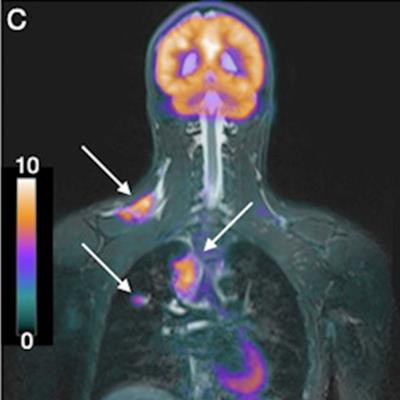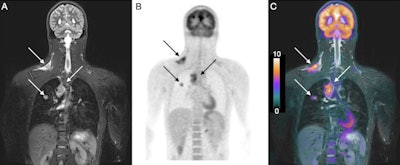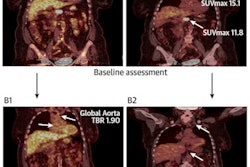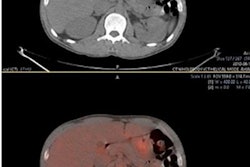
FDG-PET/MRI is a "promising alternative" to FDG-PET/CT for staging and gauging treatment response for Hodgkin lymphoma, with the benefit of less radiation to pediatric and adolescent patients, according to a study published online February 19 in the Journal of Nuclear Medicine.
FDG-PET/MRI achieved sensitivity and specificity greater than 95% for cancer detection and sensitivity of 83% and specificity of 100% in determining early postchemotherapy treatment response among 24 patients, essentially mirroring the proficiency of FDG-PET/CT.
"This prospective observational study demonstrates that FDG-PET/MRI is a promising alternative to FDG-PET/CT for staging and chemotherapy response assessment for pediatric [Hodgkin's] lymphoma," wrote the researchers, led by first author Dr. Martijn Verhagen, pediatric radiologist at University Medical Center Groningen, the Netherlands. "By replacing FDG-PET/CT with FDG-PET/MRI, children with Hodgkin lymphoma will receive a lower cumulative radiation dose at staging and response assessment, whilst maintaining diagnostic accuracy."
CT and FDG-PET have long been used to diagnose and assess cancer, but the modalities' use of ionizing radiation has raised concerns for the possibility of secondary malignancies, especially among children and young adults who undergo multiple scans. As clinicians balance those risks against the patients' benefits, FDG-PET/MRI has emerged as a potentially viable option, given that the hybrid modality can reduce radiation exposure by as much as 80%, according to several studies, and still collect relevant anatomical and metabolic information on suspected cancer cases.
For this study, Verhagen and colleagues sought to determine whether FDG-PET/MRI could be an accurate diagnostic alternative to FDG-PET/CT for both staging and early response assessment, as they prospectively targeted pediatric and adolescent children with Hodgkin lymphoma.
The researchers analyzed 24 patients (mean age, 15.4; range 8-19.5 years) who were consecutively recruited in 2015 and 2016 with confirmed cases of Hodgkin lymphoma. All two dozen subjects underwent FDG-PET/CT (Discovery, GE Healthcare) and FDG-PET/MRI (Biograph mMR, Siemens Healthineers) scans, with 24 subjects evaluated for staging and 21 patients continuing on to assess their response to chemotherapy.
In regard to staging, FDG-PET/CT detected 141 positive nodules (20%) from the 696 sites anomalies, compared with FDG-PET/MRI, which discovered 135 true-positive sites (19%). In addition, FDG-PET/CT reported 560 true-negative results (80%), compared with 551 true-negative findings (79%) for FDG-PET/MRI. The results proved to have no statistically significant difference.
 Coronal short tau inversion-recovery (STIR) (A), FDG-PET (B), and FDG-PET/MRI (C) fused images show how the hybrid modality detected right supraclavicular fossa and right paratracheal lymphadenopathy, as well as a right lung nodule (arrows), in a 14-year-old male with Hodgkin lymphoma. Images courtesy of the Journal of Nuclear Medicine.
Coronal short tau inversion-recovery (STIR) (A), FDG-PET (B), and FDG-PET/MRI (C) fused images show how the hybrid modality detected right supraclavicular fossa and right paratracheal lymphadenopathy, as well as a right lung nodule (arrows), in a 14-year-old male with Hodgkin lymphoma. Images courtesy of the Journal of Nuclear Medicine.As for response assessment, FDG-PET/CT spotted six true positives (0.9%), which would indicate an incomplete treatment outcome, among a total of 609 disease sites. By comparison, FDG-PET/MRI detected five of those six true positives (0.8%), with one incomplete treatment response missed due to a "perceptual error." When the researchers corrected for that miscue, they achieved "perfect agreement" for staging and "excellent response assessment agreement" between FDG-PET/MRI and FDG-PET/CT, they added. Again, there was no statistically significant difference.
"In our cohort of patients, FDG-PET/MRI showed no difference in overall staging compared to FDG-PET/CT for staging of Hodgkin lymphoma in children and adolescents, and there was excellent response assessment agreement," the authors concluded. "With the aim of reducing cumulative radiation dose, we suggest that pediatric/adolescent Hodgkin lymphoma staging and response assessment may be performed using FDG-PET/MRI instead of FDG-PET/CT, wherever possible."




















